Art Gallery of New South Whales I visited the Yiribana Gallery at the Art Gallery of New South Whales. The Art Gallery, located in CBD of Sydney, was established in 1871 and presents international and Australian art, ranging from contemporary art to 19th century Australian works to Aboriginal and Torres Strait Islander art. The Gallery acknowledges that the Gadigal people of the Eora nation are the traditional custodians of the land on which the Art Gallery of NSW is located. For my online gallery, I posted pictures of nine different artworks from various artists. Some pieces I chose because they were visually stimulating while others, I was drawn to because of the story that was attached to it. While I was walking through the gallery, I was surprised to learn that many of the artists are related to each other or featured in each other’s work. In my online gallery, I posted two paintings, titled “Wangkardu” and “Marpa”. Both of these works look very similar, they both are made from the same materials and consist of the same colour scheme, representing landscapes through an abstract lens. After reading the descriptions of both, I learned that the artists of these paintings are married to each other. I find it very interesting that each artist based their painting off of very different locations, yet both paintings have visual similarities, indicating a strong influence that they must have on one another. Another piece that drew my attention was “Chinaman’s Garden massacre” by Rusty Peters. This painting is simplistic and only contains three colours: white, black, and red. This painting is a visual representation of a massacre that happened in Halls Creek, where Peters’ relatives were killed. In the description next to the painting, Peters explains that the site of the massacre is in between the two gum trees and the house of those who carried out the killings is on the other side of the Panton River. The house, river, and trees are all painted black while the m...
Don't wanna be here? Send us removal request.
Photo
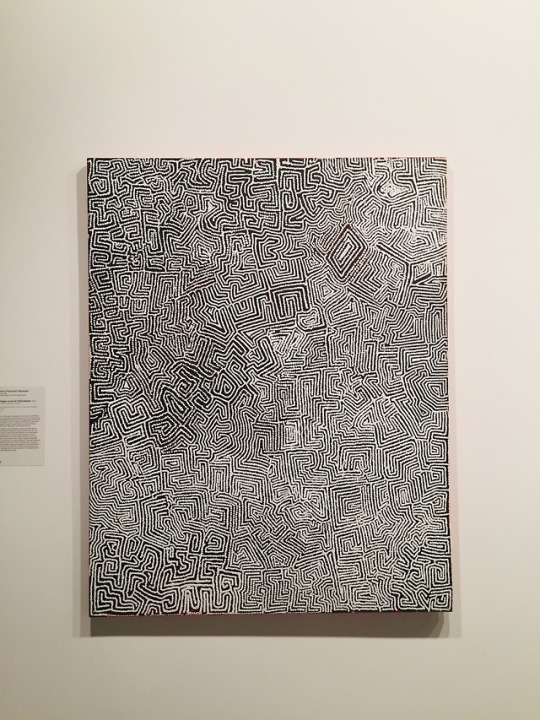

Top:
“Tingari cycle at Wilkinkarra” by Timmy Payungka Tjapangati, 1996, synthetic polymer paint on canvas
In this painting, Tjapangati fills the canvas with interlocking ‘key’ design that may also be found incised onto pearl shells and wooden objects, from Broome and into the desert regions of central Australia. The work refers to the travels of the Tingari men at the large salt lake of Wilkinkarra or Lake Mackay, with the optical effects providing a visual link to their ongoing role in activating this landscape. Despite the simplicity of the abstract geometry in this painting, this style of painting highlighted Tjapangati’s ceremonial authority.
Bottom:
My drawing of “Tingari cycle at Wilkinkarra”
0 notes
Photo
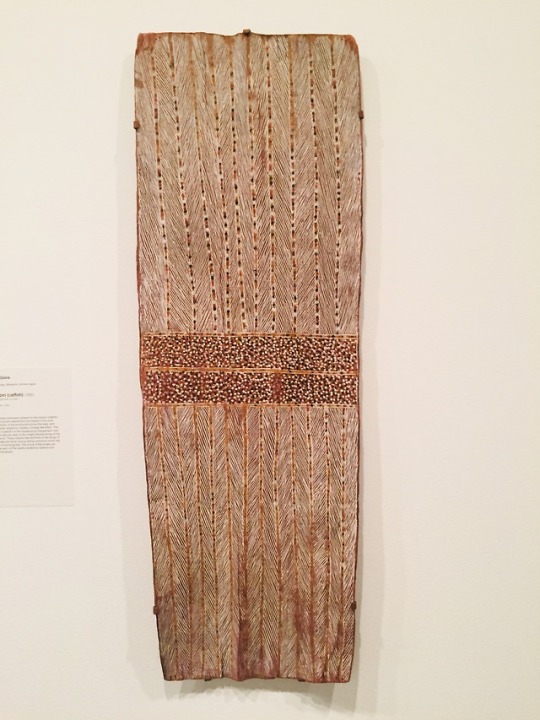
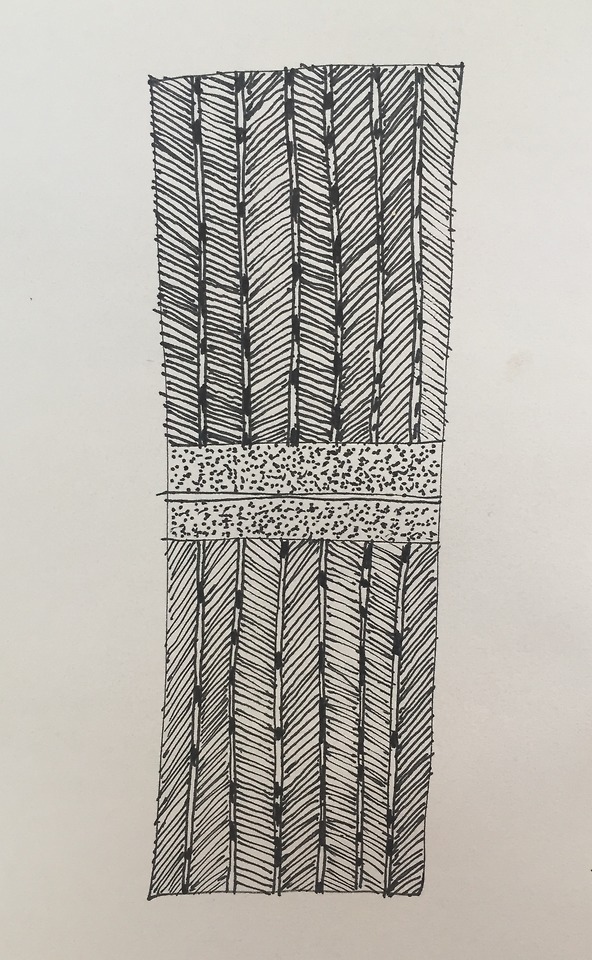
Top:
“Manpiri (catfish)” Tom Djäwa, c1950, natural pigments on bark
The refined minimalism inherent in the manpiri (catfish) design is given inspired form by Djäwa in this work. The delicacy of the brushwork across the bark, with only subtle variations, creates a mirage-like effect. This design is specific to the Gupapuyngu Daygurrgurr clan.
Bottom:
My drawing of “Manpiri (catfish)”
0 notes
Photo
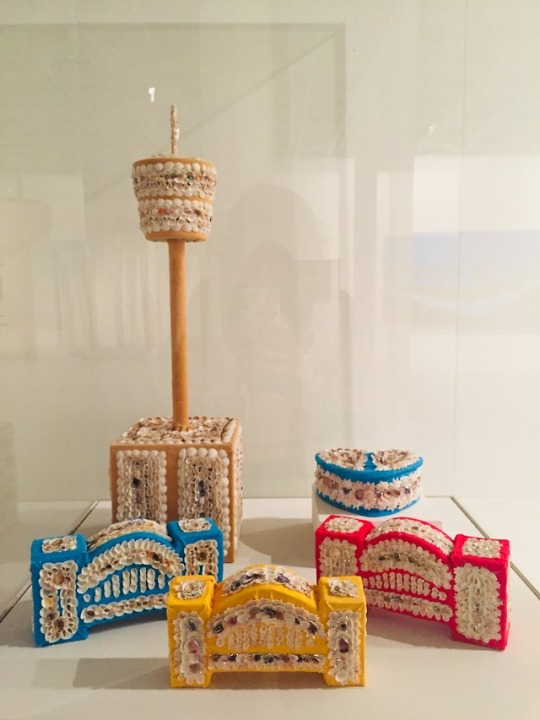
“Sydney Harbour Bridge” by Esme Timbery, 2002, cardboard, shells, fabric and glitter [front]
“Centrepoint Tower” by Esme Timbery, 2002, assorted shells, fabric, cardboard [back left]
“Heart-shaped box” by Esme Timbery, 2006, cardboard, shells, fabric and glitter [back right]
“La Per” women artists have been working with and earning an income from shellwork for generations. Timbery learnt shellwork as a young girl from her mother, grandmother and aunts by first sorting the shells by type, size and colour. A cardboard base is used to sculpt the subjects and this is then covered with material before being ‘shelled’. The shell designs and patterns are inherited.
0 notes
Photo
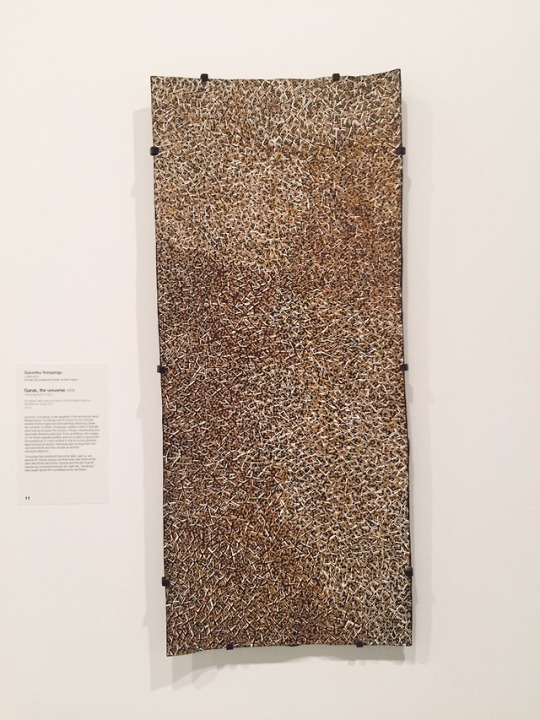
“Garak, the universe” by Gulumbu Yunupingu, 2009, natural pigments on bark
Yunupingu is known for her intricate larrakitj (hollow logs) and bark paintings depicting Garak, the universe. Yunupingu creates a web of delicate stars that encompass the surface, infinite, mesmerising and seemingly flickering with light. From a distance, the images on her works appear pixilated and one is able to appreciate the gradations of colour evident in the fine ochre painting . Approaching the works, individual stars emerge from the vast patchwork and then recede as another demands attention.
Yunupingu has explained that some stars, gan’yu, are special for Yolngu people and that when she looks that the stars she thinks about the universe and the fact that all people are connected through the night sky.
0 notes
Photo
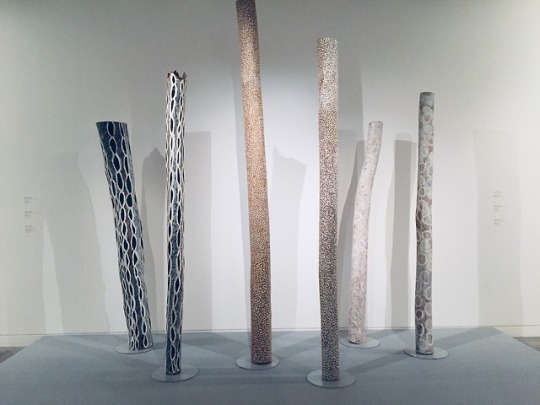
“Gurtha” by Barrupu Yunupingu, 2012, natural pigments on wood
“Garak, the universe” by Gulumbu Yunupingu, 2007, natural pigments on wood
0 notes
Photo
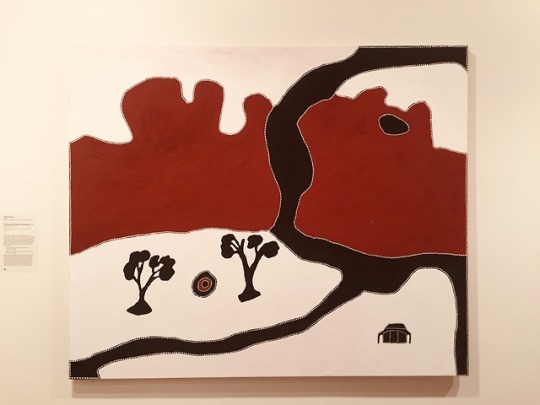
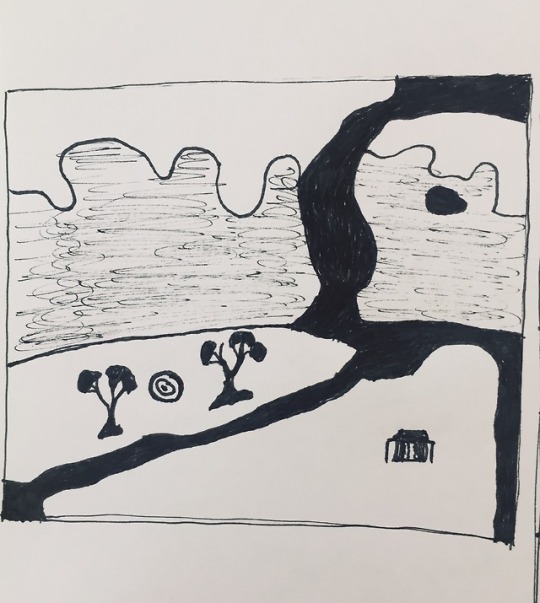
Top:
“Chinaman’s Garden massacre” by Rusty Peters, 2000, natural pigments on linen
This painting documents the country around Yaranggan, which belonged to his mother’s family. They used to live here, along with a Chinese man who had a vegetable garden and worked with the Gija people to collect dingo skins that he took to Halls Creek to exchange for food. On one of his trips to Halls Creek, the Gija people living here were killed. As Peters has recalled:
They shot them all there, and all the babies...
hit them on the tree
When we look around here we see only the country
they left, poor things.
Peters’ uncle avoided the massacre and was able to tell people what had unfolded by hiding in a cave and later escaping through a hole in the mountain, shows in the painting as a simple black oval within the red mountain range. The site of the massacre is marked between the two gum trees, while the house of those who carried out the killings is also included on the other side of the Panton River near the junction with an adjoining creek.
Bottom:
My drawing of “Chinaman’s Garden massacre”
0 notes
Photo
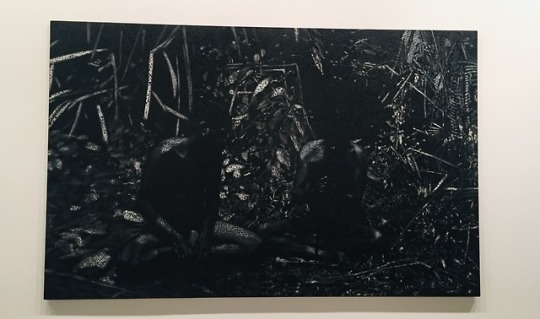
Untitled (FS) by Daniel Boyd, 2016, oil, charcoal and archival glue on linen
0 notes
Photo

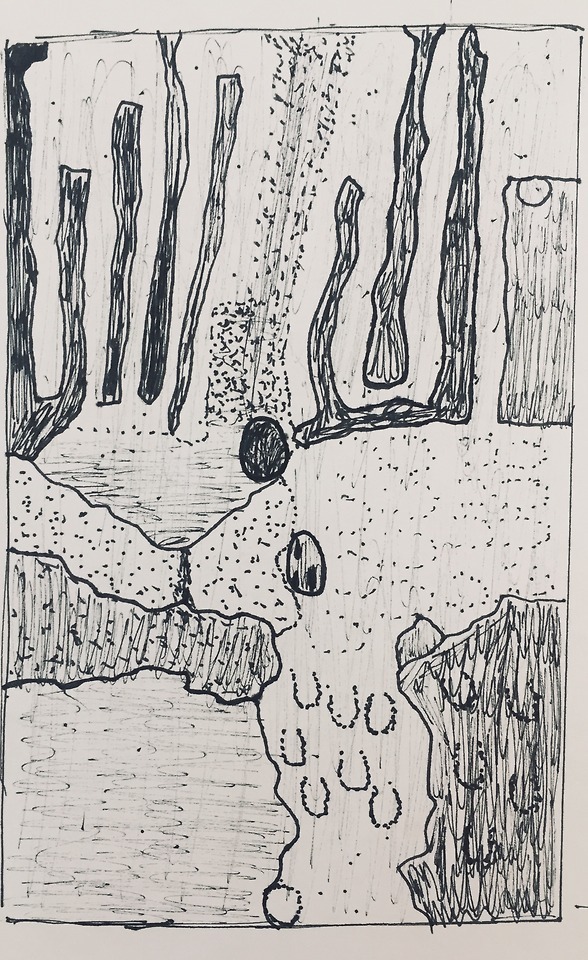
Top:
“Marpa” by Lucy Yukenbarri Napanangka, 2001, synthetic polymer paint on linen
“Marpa” refers to Napanangka’s grandparents’s country and features a central rock hole surrounded by the bountiful food found here, for example, kantilli (bush raisin). The kurkapi (desert oak) is also found here, depicted as the three solid bands of colour. The majority of the painting depicts tali (sand hills), which dominate the landscape in the Great Sandy Desert. Napanangka was one of the leading artists at Wirrimanu (Balgo) and she often painted alongside her husband Helicopter Tjungurrayi.
Bottom:
My drawing of “Marpa”
0 notes
Photo
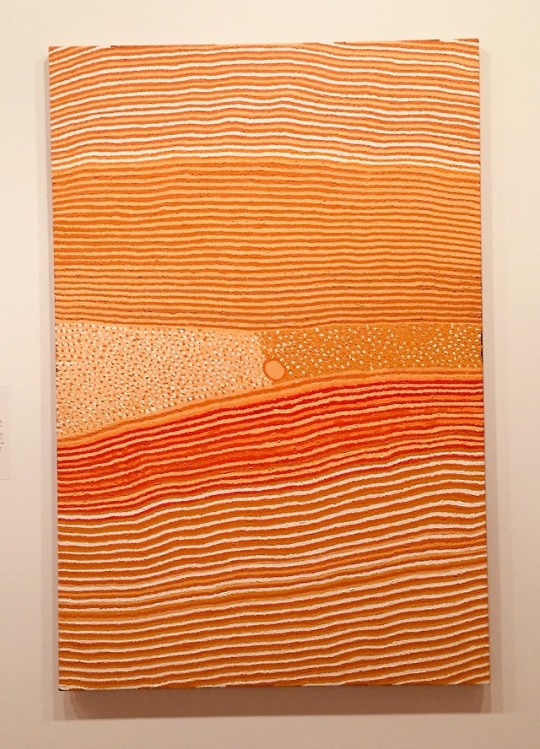
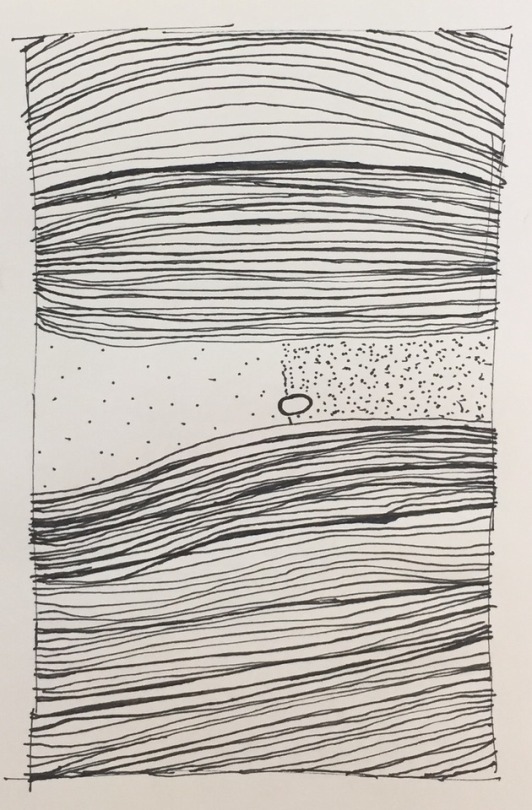
Top:
"Wangkardu” by Helicopter Tjungurrayi, 2001, synthetic polymer paint on linen
Wangkardu is the country where Helicopter Tjungurrayi was born and spent his early life. This is located south-west of Wirrimanu in the Great Sandy Desert. The majority of this painting represents the tali (sand dunes) which dominate the area. In the centre is the inta, or living water, at Wangkardu around which many families would camp. Tjungurrayi is known for his distinct linear designs emanating from a central water feature.
Bottom:
My drawing of "Wangkardu”
1 note
·
View note